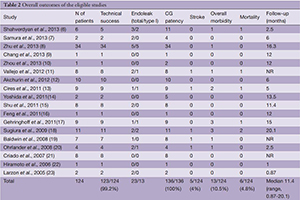The chimney-graft technique for preserving supra-aortic branches: a review
Abstract
Evolution in the endovascular era has influenced the management of aortic arch pathologies. “Chimney” or “snorkel” graft technique has been used as an alternative in high risk patients unfit for open repair. We reviewed the published literature on the chimney graft technique for preservation of the supra-aortic branches in order to provide an extensive insight of its feasibility and efficacy and investigate its outcomes. 18 reports were identified, with a total of 124 patients and 136 chimney. Primary technical success was achieved in 123/124 patients (99.2%). The perioperative mortality rate was 4.8% and the stroke rate was 4%, while events of spinal cord ischemia were rare. The overall endoleak rate was 18.5%; 13 patients (10.5%) developed a type I endoleak and 10 (8%) patients a type II endoleak. During a median follow-up period of 11.4 months (range, 0.87-20.1 months) all implanted chimney grafts remained patent. From this, we conclude that endovascular aortic arch repair with chimney grafts is associated with a lower mortality rate compared to totally open and hybrid reconstruction. However, the stroke rate remains noteworthy, and requires longterm data to elucidate.
Cover






